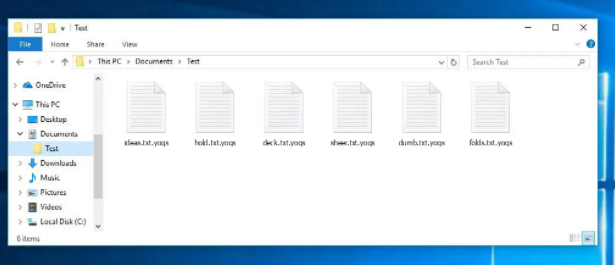What is Yoqs Ransomware virus
The ransomware known as Yoqs Ransomware is categorized as a highly damaging threat, due to the possible harm it could do to your computer. It is likely you’ve never ran into this type of malicious software before, in which case, you may be especially shocked. Powerful encryption algorithms are used for file encryption, and if it successfully encrypts your files, you will not be able to access them any longer.
The reason this malicious program is thought to be a serious threat is because it isn’t always possible to decrypt files. Crooks will give you a decryption tool but giving into the demands might not be the best idea. There are numerous cases where a decryption tool wasn’t provided even after paying the ransom. Keep in mind that you are expecting that criminals will feel obligated to help you in file recovery, when they don’t have to. That money would also finance future malicious software projects. Data encrypting malicious program is already costing millions of dollars to businesses, do you really want to be supporting that. The more victims pay, the more profitable it becomes, thus attracting more people who are lured by easy money. Situations where you might lose your data may occur all the time so a much better purchase might be backup. If you had a backup option available, you may just remove Yoqs Ransomware virus and then recover data without being anxious about losing them. We’ll provide info on file encrypting malicious program spread methods and how to avoid it in the following paragraph.
Ransomware distribution ways
You can commonly see ransomware added to emails or on suspicious download websites. There’s usually no need to come up with more sophisticated ways as plenty of people are not careful when they use emails and download files. More sophisticated ways can be used as well, although not as frequently. All criminals have to do is use a famous company name, write a convincing email, attach the infected file to the email and send it to possible victims. Topics about money are commonly used because people are more prone to opening those emails. And if someone who pretends to be Amazon was to email a person about dubious activity in their account or a purchase, the account owner would be much more inclined to open the attachment. There a couple of things you ought to take into account when opening email attachments if you want to keep your device secure. Check the sender to make sure it’s someone you know. And if you do know them, check the email address to make sure it matches the person’s/company’s real address. Those malicious emails are also often full of grammar mistakes. You ought to also check how the sender addresses you, if it’s a sender who knows your name, they will always greet you by your name, instead of a typical Customer or Member. Weak spots on your system Out-of-date programs could also be used to infect. All software have weak spots but when they are found, they’re regularly fixed by vendors so that malware can’t use it to get into a system. Unfortunately, as as may be seen by the widespread of WannaCry ransomware, not all users install updates, for one reason or another. We encourage that you frequently update your programs, whenever a patch becomes available. Updates may also be permitted to install automatically.
What can you do about your files
A file encrypting malware doesn’t target all files, only certain types, and they’re encrypted as soon as they’re identified. If you didn’t notice that something is wrong initially, you will certainly know something’s up when your files cannot be opened. Look for strange file extensions attached to files that were encrypted, they ought to show the name of the file encoding malicious software. A powerful encryption algorithm might be used, which would make decrypting data highly difficult, if not impossible. After all files have been locked, a ransom notification will be placed on your computer, which will attempt to clear up what has happened and how you should proceed. The decryption tool proposed won’t be for free, obviously. The price for a decryptor ought to be displayed in the note, but if it’s not, you will be asked to email them to set the price, so what you pay depends on how valuable your files are. Clearly, paying the ransom isn’t suggested. Thoroughly think all your options through, before you even consider giving into the demands. Maybe you have simply forgotten that you have backed up your files. It could also be a possibility that you would be able to locate a program to unlock Yoqs Ransomware files for free. If the ransomware is crackable, someone might be able to release a decryptor for free. Before you make a decision to pay, look into that option. Investing part of that money to buy some kind of backup might do more good. If your most essential files are stored somewhere, you just uninstall Yoqs Ransomware virus and then proceed to file recovery. In the future, make sure you avoid ransomware and you can do that by becoming aware of its spread ways. Stick to legitimate download sources, be careful when opening email attachments, and ensure software is updated.
Methods to erase Yoqs Ransomware
In order to get rid of the data encoding malware if it’s still present on the computer, employ ransomware. It might be tricky to manually fix Yoqs Ransomware virus because you could end up accidentally damaging your system. Instead, using an anti-malware program would not put your device in jeopardy. This tool is useful to have on the computer because it will not only ensure to get rid of this threat but also put a stop to similar ones who try to enter. Find which malware removal program best suits what you need, install it and permit it to execute a scan of your computer to identify the threat. However, the program will not be able to restore data, so don’t expect your data to be recovered once the threat has been cleaned. When your device is free from the infection, start routinely create copies of your data.
Offers
Download Removal Toolto scan for Yoqs RansomwareUse our recommended removal tool to scan for Yoqs Ransomware. Trial version of provides detection of computer threats like Yoqs Ransomware and assists in its removal for FREE. You can delete detected registry entries, files and processes yourself or purchase a full version.
More information about SpyWarrior and Uninstall Instructions. Please review SpyWarrior EULA and Privacy Policy. SpyWarrior scanner is free. If it detects a malware, purchase its full version to remove it.

WiperSoft Review Details WiperSoft (www.wipersoft.com) is a security tool that provides real-time security from potential threats. Nowadays, many users tend to download free software from the Intern ...
Download|more


Is MacKeeper a virus? MacKeeper is not a virus, nor is it a scam. While there are various opinions about the program on the Internet, a lot of the people who so notoriously hate the program have neve ...
Download|more


While the creators of MalwareBytes anti-malware have not been in this business for long time, they make up for it with their enthusiastic approach. Statistic from such websites like CNET shows that th ...
Download|more
Quick Menu
Step 1. Delete Yoqs Ransomware using Safe Mode with Networking.
Remove Yoqs Ransomware from Windows 7/Windows Vista/Windows XP
- Click on Start and select Shutdown.
- Choose Restart and click OK.

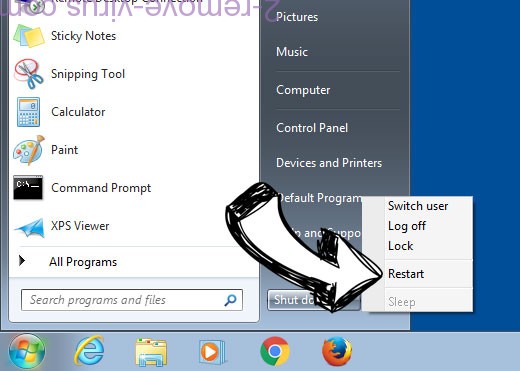
- Start tapping F8 when your PC starts loading.
- Under Advanced Boot Options, choose Safe Mode with Networking.

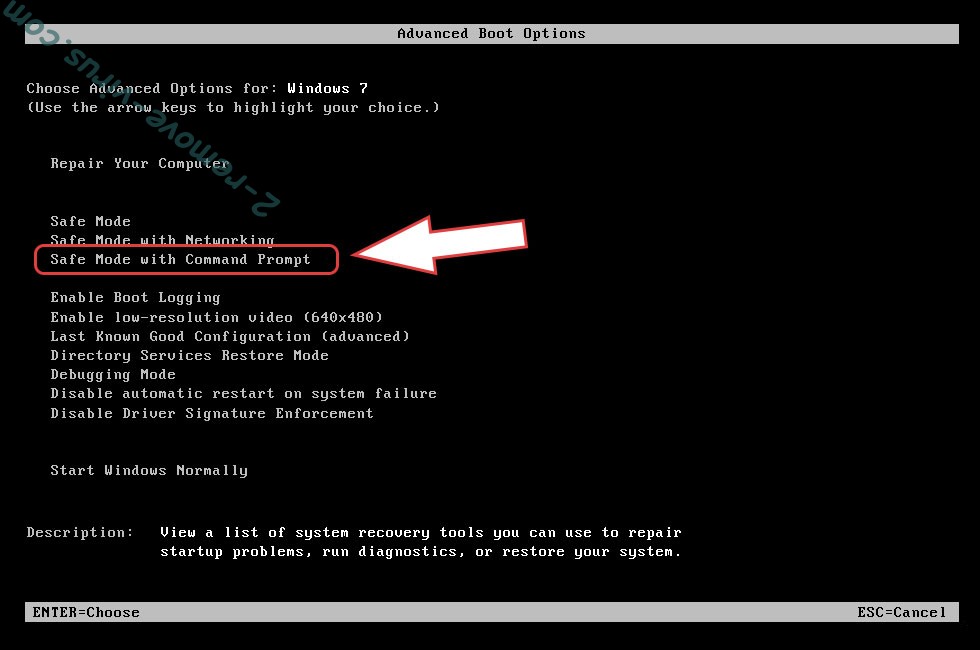
- Open your browser and download the anti-malware utility.
- Use the utility to remove Yoqs Ransomware
Remove Yoqs Ransomware from Windows 8/Windows 10
- On the Windows login screen, press the Power button.
- Tap and hold Shift and select Restart.

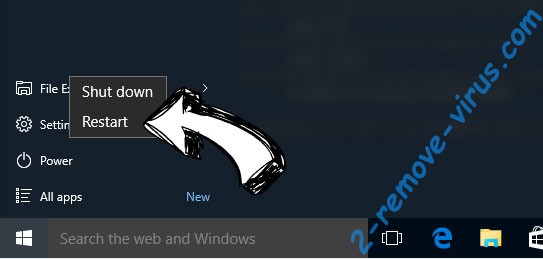
- Go to Troubleshoot → Advanced options → Start Settings.
- Choose Enable Safe Mode or Safe Mode with Networking under Startup Settings.

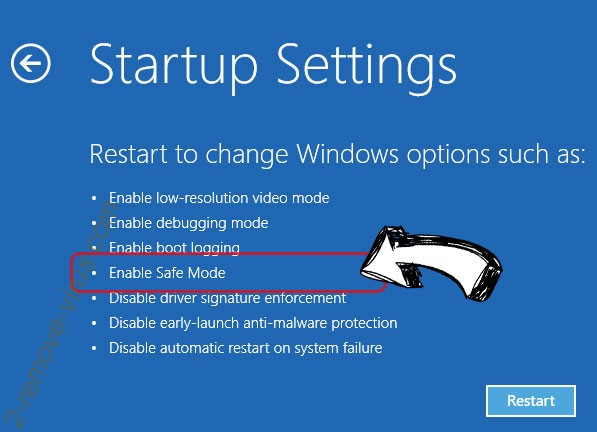
- Click Restart.
- Open your web browser and download the malware remover.
- Use the software to delete Yoqs Ransomware
Step 2. Restore Your Files using System Restore
Delete Yoqs Ransomware from Windows 7/Windows Vista/Windows XP
- Click Start and choose Shutdown.
- Select Restart and OK


- When your PC starts loading, press F8 repeatedly to open Advanced Boot Options
- Choose Command Prompt from the list.

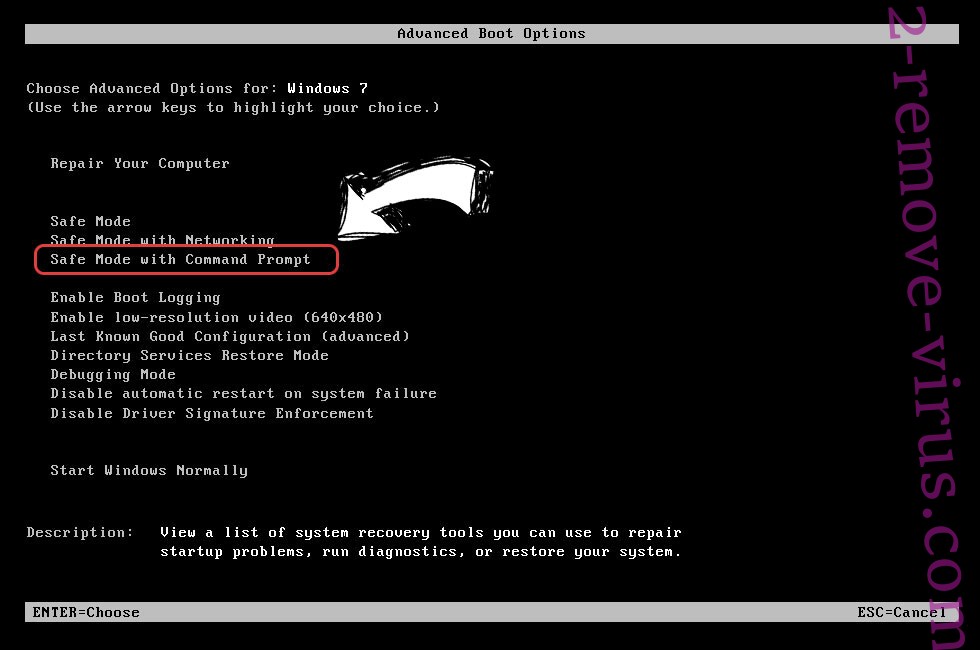
- Type in cd restore and tap Enter.

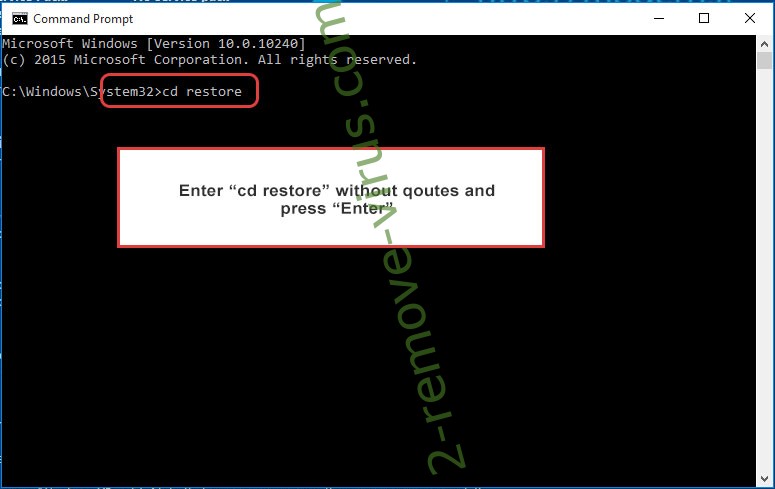
- Type in rstrui.exe and press Enter.

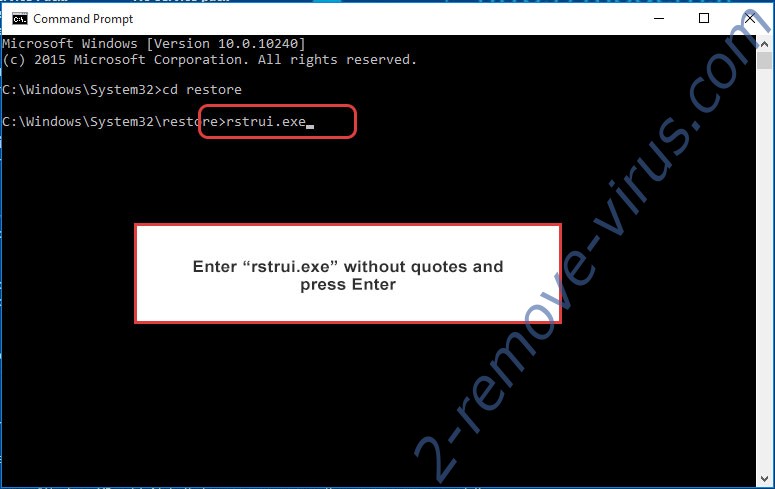
- Click Next in the new window and select the restore point prior to the infection.

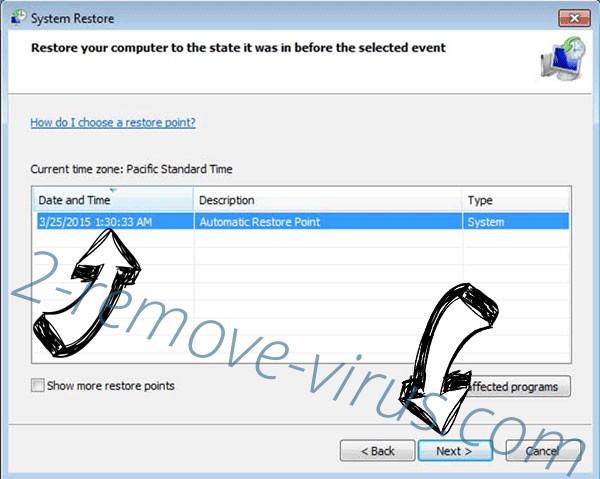
- Click Next again and click Yes to begin the system restore.

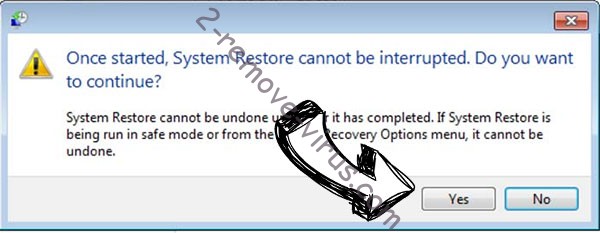
Delete Yoqs Ransomware from Windows 8/Windows 10
- Click the Power button on the Windows login screen.
- Press and hold Shift and click Restart.


- Choose Troubleshoot and go to Advanced options.
- Select Command Prompt and click Restart.

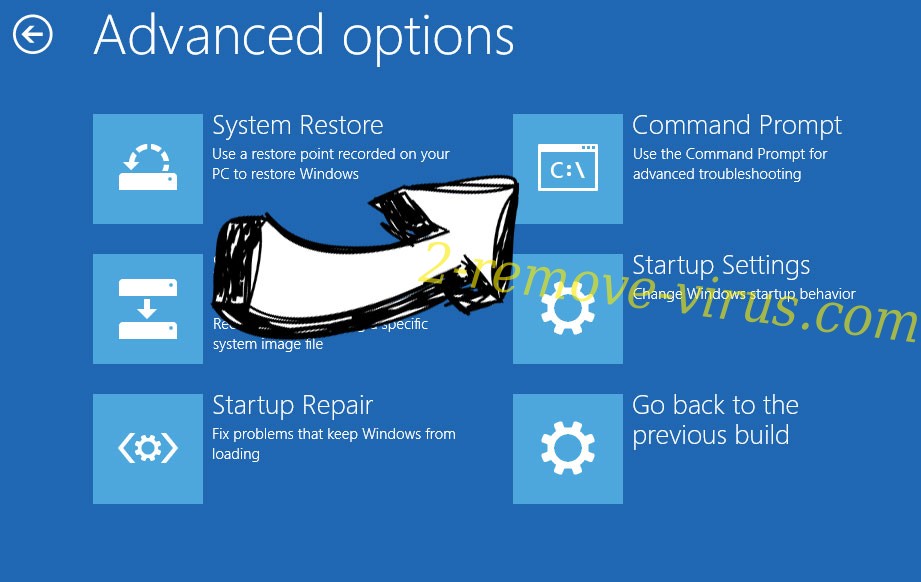
- In Command Prompt, input cd restore and tap Enter.


- Type in rstrui.exe and tap Enter again.


- Click Next in the new System Restore window.

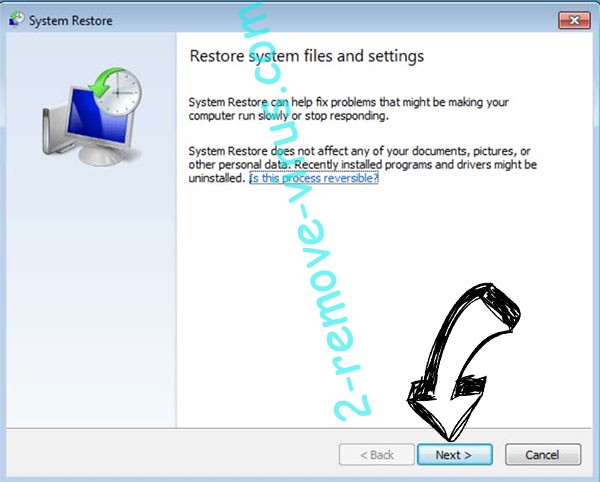
- Choose the restore point prior to the infection.


- Click Next and then click Yes to restore your system.


Site Disclaimer
2-remove-virus.com is not sponsored, owned, affiliated, or linked to malware developers or distributors that are referenced in this article. The article does not promote or endorse any type of malware. We aim at providing useful information that will help computer users to detect and eliminate the unwanted malicious programs from their computers. This can be done manually by following the instructions presented in the article or automatically by implementing the suggested anti-malware tools.
The article is only meant to be used for educational purposes. If you follow the instructions given in the article, you agree to be contracted by the disclaimer. We do not guarantee that the artcile will present you with a solution that removes the malign threats completely. Malware changes constantly, which is why, in some cases, it may be difficult to clean the computer fully by using only the manual removal instructions.
